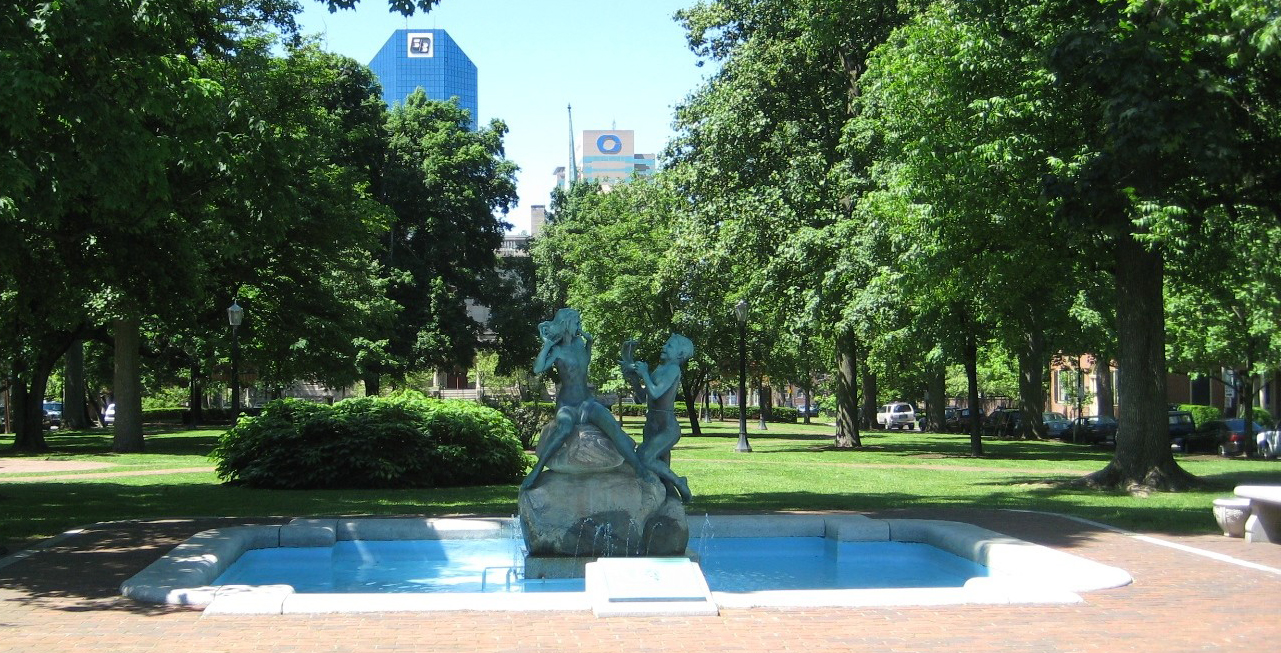
The Gratz Park historic district is located in downtown Lexington and is bounded by West Third and West Second on the north and south side, and Mill and Market Streets on the west and east sides. Considered one of the most beautiful areas of downtown, Gratz Park includes a city park (the oldest in Lexington) and 16 large private residences and historic homes that vary in style – everything from log to Victorian.
The Gratz Park Historic District was originally established in 1781 as an outlot in the town plat prepared by the Virginia Assembly. In 1793, Transylvania Seminary purchased the lot for the site of its Lexington campus. In 1816, a large 3 story structure was built to serve as the main building of the seminary. The structure was designed by Matthew Kennedy, Lexington’s first architect. Erected near the center of campus, the building and much of the campus, was destroyed by fire in 1829. At that time, the Transylvania campus moved to its present location across Third Street. Only one building remains from the original campus, The Old Kitchen Building. The Kitchen is located on the edge of Gratz Park at 253 Market Street and probably was not a kitchen at all. The building has altered very little since it was built, with the exception of some windows, doors, and modernization. The kitchen has been used for a variety of functions over the years.
In the late 19th century, the Gratz family bought the home at the corner of Mill and New Streets and became the caretakers of the park, so it became named for Benjamin Gratz, patriarch of the Gratz family. Benjamin Gratz was a leading hemp manufacturer, Transylvania University Trustee, member of the city council, a founder of Lexington’s first public library, and a founder of the Lexington Ohio Railway. During the Civil War, the park was used as a parade ground and bivouac for Union and Confederate troops. In the decade following the war, the park fell into neglect, but in 1875 Howard Gratz, the son of Benjamin Gratz and publisher of the Kentucky Gazette, decided to sell subscriptions to fund improvements to the park. It was during these improvements that a wrought iron fence was placed around the entire perimeter with double gates at the four corners. In 1879, H.M. Sanford donated the arched placed at the corners. The arch that now stands in the park is an exact replica and the attached gates are the originals. Howard Gratz completed his improvements by 1876 and on September 4, 1876, the park was dedicated as Centennial Park (the name was changed later to Benjamin Gratz Park). During the next 25 years, the park was a center for community gatherings. Howard Gratz continued to care for this property (still owned by Transylvania University) until the turn of the century. Many of the park’s tulip poplars were planted in the 1890’s after a storm ravaged the older trees located in the park.
In the early years of the 20th century, the Transylvania Board of Trustees formed a plan to subdivide the park for homes. In 1906, The Carnegie Library was built as a gift to the city of Lexington with a $60,000 donation from the Andrew Carnegie Foundation and served as Lexington’s Central Library until the late 1980’s. At that time, the building became the Carnegie Center for Literacy and Learning, an organization whose mission is to create and support programs that foster literacy and learning as a lifelong process for all citizens.
Anderson Gratz, the grandson on Benjamin Gratz, was opposed to building the Carnegie Library at Gratz Park and offered to purchase land anywhere else in the city as an alternative site. However, the city maintained that Gratz Park was the best location and negotiated with Transylvania to pay $9000 to place the building in the southern portion of the park. Anderson’s failure to save this southern portion of the park further encouraged him to preserve the northern end. In 1915, Anderson offered to pay Transylvania $21,000 for the northern portion of the park if the city of Lexington would also pay $10,000 to the college. After two years of negotiation and indecision, the deal was made. Under the agreement, the city accepted Anderson Gratz’s donation with his restriction that the land of Gratz Park could never have buildings placed within the green space. Thus, the park remains largely as it has been for over a century.
The Gratz Park Neighborhood Association was officially established in August of 1999, but has been operating as a group since the early 1950’s. In 1954, the Hart-Bradford house at the southwest corner of Second and Mill Streets had been demolished to make way for a parking lot. The owner of the parking lot had an option to purchase the Hunt-Morgan House as well, and many feared it would be destroyed in favor of a parking lot as well. Prompted by this threat, the Blue Grass Trust was established and promptly borrowed money to purchase the house. Fearing that all of Gratz Park would be in danger, residents rallied to support the Blue Grass Trust in their efforts. Residents of the park held fundraisers meant to help pay off the mortgage on the Hunt Morgan House and to pay for repairs and upkeep on the house. They also sought historic zoning that would protect their neighborhood in the future. Thus, in 1958, Gratz Park was named the first historic district in Lexington, as well as in the Commonwealth of Kentucky. The park was placed on the National Register of Historic Place in 1979 and today, is maintained by the Lexington Fayette Urban County Government Division of Parks and Recreation. In 2006, Gratz Park was named one of the nation’s first seven Preserve America Neighborhoods. The park received a $90,000+ matching grant from the National Park Service which allowed the neighborhood association to create a master plan for the park and to create a kiosk which tells of the park’s history as well as that of the homes surrounding the park.
The second weekend of May each year, Gratz Park hosts Mayfest, an arts festival that attracts thousands to the heart of downtown. This year marks the 18th anniversary of the fair held Saturday, May 12 and 13.
Click Here For Mayfest Information
Posted by Turf Town Properties on
Leave A Comment